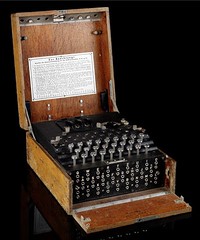
PREV ARTICLE
NEXT ARTICLE
FULL ISSUE
PREV FULL ISSUE
THE U.S MINT'S CODED TELEGRAMS
You may have to stretch a little, but you can find a numismatic connection to just about anything, at least if you ask the right people. As a technology geek I was intrigued by this auction lot description, a decidedly non-numismatic item offered by Bonham's.
-Editor
The secret operations at Bletchley Park were responsible for decoding the information communicated by this machine to gain a winning advantage over the Germans. The construction of the machine Colossus at Bletchley Park, thanks to the efforts of British Intelligence, meant the messages scrambled by the enigma machine could eventually be decoded in under twenty-four hours, leading the allies to an early victory. To read the complete article, see: Extremely rare WWII German enigma enciphering machine on sale at Bonhams (www.artdaily.org/index.asp?int_sec=2&int_new=58769#.UJ6xa4dlEfM)
I passed this along by email to a couple friends, never thinking the subject would come back to numismatics.
-Editor
Roger Burdette writes: There were quite a few code machines used from the latter 19th century to the WW-II period. Most were commercial devices intended for production of coded telegrams. This was used to reduce the cost of telegrams by replacing multi-word phrases with single word text. The U.S. Mint used this from about 1910 to 1925, but I don't know if they used a machine or just a code book. Here's an excerpt from the book draft "From Mine to Mint" that explains a little more. Coded telegrams were in common use by business and government from about 1845 to the 1930s. Thousands of code books were published or issued privately, but they are largely forgotten now. There were also code generating machines that could be used to develop a business’ own private codes and cyphers. They present a finely-grained window into their respective domains and their time. Dictionaries of phrases and codewords, or cipher components, were commonly used in the age of telegraphy to compress messages and thereby economize on wire costs. A telegram from the United States to England could cost 25-cents per word during the early 1900s. They were also used to achieve a basic level of secrecy for communications. There were different kinds of codes, different arrangements of phrase matter, different means of assembling and dis-assembling messages. Typically, a sender would choose from the dictionary’s selections those phrases or expressions (about the quality of cotton, for example) that satisfied his intentions, and take the codewords associated with the selections. It is the coded message, packaged for transport, that would be processed and sent along its way by the telegraph or cable company. The recipient of the message would unpack its original meanings by looking the code words up in another copy of the same dictionary – they were listed in alphabetical order – or by following a sequence of other procedures to arrive at the meaning.
Interesting! An early form of data compression, motivated by money savings. Neat.
Part of the text Roger provided was paraphrased from: John McVey, Telegraphic Codes and Message Practice, 1870-1945. 2007. It's footnoted in his manuscript.
-Editor
Wayne Homren, Editor The Numismatic Bibliomania Society is a non-profit organization promoting numismatic literature. See our web site at coinbooks.org. To submit items for publication in The E-Sylum, write to the Editor at this address: whomren@gmail.com To subscribe go to: https://my.binhost.com/lists/listinfo/esylum All Rights Reserved. NBS Home Page Contact the NBS webmaster 
|
